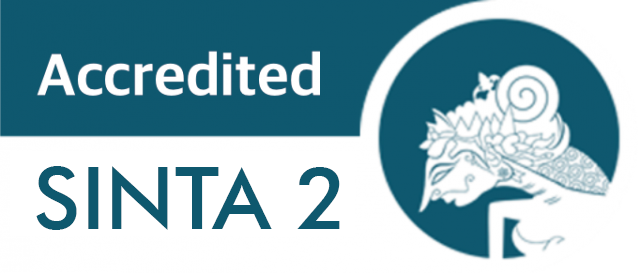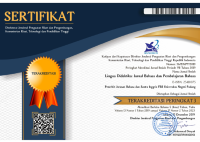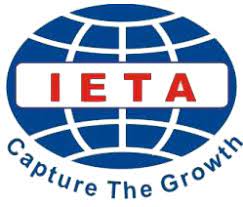TEACHERS DIRECTIVE SPEECH ACTS IN MUHADARAH ACTIVITIES IN MTSN LUBUK BUAYA KOTA PADANG
 ),
), (1) Universitas Negeri Padang
 Corresponding Author
Corresponding Author
Copyright (c) 2018 Lingua Didaktika: Jurnal Bahasa dan Pembelajaran Bahasa
DOI : https://doi.org/10.24036/ld.v7i2.10349
Full Text:
 Language : en
Language : en
Abstract
Position and function of oral literature including folklore is increasingly displaced due to technological advances, cultural systems, social systems, and political systems are developed. Therefore, efforts should be made documenting folklore Rambah society. The purpose of this study was to describe the categories, structure and social functions contained in the folklore society Rambah. This study used a qualitative approach with descriptive methods. Object of this study is the folklore society Sand Pengaraian Rambah district. Data collection was done by recording, recording and interviews. Then proceed to describe and interpret the results. Data analysis was performed through a data inventory phase, phase of data analysis, and reporting phases. Based on the research and discussion of public folklore Rambah divided into three categories, namely fairy tales, legends, and myths. Of the fourteen stories, stories that have category found eight legends, myths category four stories, and a bit of a fairy tale by the two stories. In terms of structure, folklore Rambah people are more likely to use the plot forward and a third person perspective. Moreover, in terms of style more common stylistic comparison, repetition, and contradiction. Rambah folklore society serves as a means of entertainment, education, faith bequeathed the means, the means to preserve the customs, culture, and traditions, shows Rambah community identity, as well as a means of fostering a spirit of togetherness. The results could be implicated in the Indonesian language learning with understanding the competency standard spoken folklore.
Keywords
References
Ahimsa-Putra, dan Heddy, Shri. 2001. Strukturalisme Levi Strauss Mitos dan Karya Sastra. Yogyakarta: Galang Printika.
Aminuddin. 2004. Pengantar Apresiasi Karya Sastra. Bandung: Sinar Baru Algesindo.
Atmazaki. 2007. Ilmu Sastra: Teori dan Terapan. Padang: UNP Press.
Bunanta, Murti. 1998. Problematika Penulisan Cerita Rakyat untuk Anak di Indonesia. Jakarta: Balai Pustaka.
Danandjaja, James. 2007. Folklor Indonesia, Ilmu Gosip, Dongeng, dan lain-lain. Jakarta: Pustaka Utama Grafiti.
Endraswara, Suwardi. 2009. Metodologi Penelitian Sastra: Epistemologi, Model, Teori, dan Aplikasi. Yogyakarta: FBS Universitas Negeri Yogyakarta.
Endraswara, Suwardi. 2011. Metode Penelitian Folklor: Konsep, Teori, dan Aplikasi. Yogyakarta: MedPress.
Esten, Mursal. 1999. Kajian Transformasi Budaya. Bandung. Angkasa.
Hutomo, Suripan, Sadi. 1991. Mutiara yang Terlupakan. Malang: Dioma.
Ibrahim, Maniyamin. 2009. Konteks Sastra Melayu & Budaya Melayu. Malaysia: Karisma Publications Sdn. Bhd.
Koentjaraningrat. 2009. Pengantar Ilmu Antropologi. Jakarta: Aksara Baru.
Mahmud, Saifuddin dkk. 2000. Struktur Sastra Lisan Simeulue. Jakarta: Pusat Bahasa.
Marzali, Amri. 2009. Antropologi dan Pembangunan Indonesia. Jakarta: Prenada Media.
Moleong, Lexy J. 2010. Metodologi Penelitian Kualitatif. Bandung: PT. Remaja Rosdakarya.
Muslim, Abu. 2011. “Ekspresi Kebijaksanaan Masyarakat Bugis Wajo Memelihara Anak (Analisis Sastra Lisan): Wisdom Expression of Bugineese Wajo Community in Caring Children (Oral Litelature Analysis)”. Jurnal Al Qalam: Vol. 17 No. 1 Edisi Januari – Juni. Makassar: Balai Penelitian dan Pengembangan Agama Makassar.
Pudentia. 2008. Metodologi kajian Tradisi Lisan. Jakarta: Asosiasi Tradisi Lisan (ATL).
Sedyawati, Edi dkk. 2004. Sastra Melayu Lintas Daerah. Jakarta: Pusat Bahasa.
Semi, Atar. 1984. Anatomi Sastra. Padang: Sridarma.
Semi, Atar. 2008. Stilistika Sastra. Padang: Universitas Negeri Padang Press.
Sunardjo, Nikmah dkk. 2000. Struktur Karya dan Nilai Budaya: dalam Hikayat Pak Belalang dan Lebai Malang, Hikayat Abu Nawas, dan Hikayat Mahsyud Hak. Jakarta: Pusat Bahasa.
Syam, Junaidi. 2012a. Sejarah Kerajaan Lima Luhak. Rokan Hulu: Dinas Kebudayaan dan Pariwisata Kabupaten Rokan Hulu.
Syam, Junaidi. 2012b. Teromba Rokan. Rokan Hulu: Dinas Kebudayaan dan Pariwisata Kabupaten Rokan Hulu.
Zainuddin, Diah dkk. 1987. Sastra Lisan Melayu Riau: Bentuk, Fungsi dan Kedudukannya. Pekanbaru: Depdikbud.
 Article Metrics
Article Metrics
 Abstract Views : 423 times
Abstract Views : 423 times
 PDF Downloaded : 98 times
PDF Downloaded : 98 times
Refbacks
- There are currently no refbacks.
Copyright (c) 2018 Lingua Didaktika: Jurnal Bahasa dan Pembelajaran Bahasa

This work is licensed under a Creative Commons Attribution-NonCommercial 4.0 International License.









